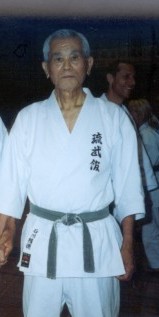 Ishikawa Seitoku, 87-years old, is one of the few remaining direct long-term students of Chibana Choshin (1885-1969). Although not well known outside Okinawa, he is a 10th dan in Kobayashi Shorin-ryu and highly respected on the island. Ishikawa started training as a youngster with his brother and his brother's friend, the famous Arakaki Ankichi, then continued with Shimabukuro [Zenryo or Tatsuo?] Sensei and Chibana Sensei during their lifetimes," according to a person who knows him. He was a close personal friend of Nagamine Shoshin and vice-president of Miyahira Katsuya's association for many years. After Miyahira's death in November 2012, he succeeded as the third president of the Okinawa Shorin-ryu Karatedo Kyokai, following Chibana and Miyahira. He was chosen to deliver the keynote address at the October 2012 "City of Karate and Kobudo, Naha" Forum. Along with fellow Shorin-ryu masters Maeshiro Morinobu, Higa Minoru, Nakazato Minoru, and a host of masters from other styles, Ishikawa Hanshi is scheduled to teach at the September 9-14, 2013 Okinawa Traditional Karatedo Seminar organized by the Okinawan Prefecture Government. This will be a six-day affair held at the Okinawa Prefecture Budokan
Ishikawa Seitoku, 87-years old, is one of the few remaining direct long-term students of Chibana Choshin (1885-1969). Although not well known outside Okinawa, he is a 10th dan in Kobayashi Shorin-ryu and highly respected on the island. Ishikawa started training as a youngster with his brother and his brother's friend, the famous Arakaki Ankichi, then continued with Shimabukuro [Zenryo or Tatsuo?] Sensei and Chibana Sensei during their lifetimes," according to a person who knows him. He was a close personal friend of Nagamine Shoshin and vice-president of Miyahira Katsuya's association for many years. After Miyahira's death in November 2012, he succeeded as the third president of the Okinawa Shorin-ryu Karatedo Kyokai, following Chibana and Miyahira. He was chosen to deliver the keynote address at the October 2012 "City of Karate and Kobudo, Naha" Forum. Along with fellow Shorin-ryu masters Maeshiro Morinobu, Higa Minoru, Nakazato Minoru, and a host of masters from other styles, Ishikawa Hanshi is scheduled to teach at the September 9-14, 2013 Okinawa Traditional Karatedo Seminar organized by the Okinawan Prefecture Government. This will be a six-day affair held at the Okinawa Prefecture Budokan 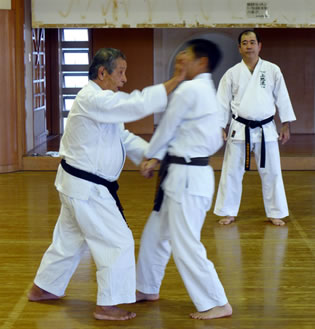 Uehara Takenobu, an 83-year-old master of Uechi-ryu, will also be one of the teachers at the September 2013 Seminar, along with fellow Uechi-ryu masters Tomoyose Ryukou, Nakahodo Tsutomu, Uehara Takenobu, Senaga Yoshitsune, and Shinjo Kiyohide. Uehara heads the Uechi-Ryu Karatedo Shinko-kai, one of the splinter groups that emerged after the death of the founder's son and heir, Uechi Kanei (1911-1991). Uehara is the son of Uehara Saburo (1890-1965), reputedly the second student of the founder, Uechi Kanbun (1877-1948).
Uehara Takenobu, an 83-year-old master of Uechi-ryu, will also be one of the teachers at the September 2013 Seminar, along with fellow Uechi-ryu masters Tomoyose Ryukou, Nakahodo Tsutomu, Uehara Takenobu, Senaga Yoshitsune, and Shinjo Kiyohide. Uehara heads the Uechi-Ryu Karatedo Shinko-kai, one of the splinter groups that emerged after the death of the founder's son and heir, Uechi Kanei (1911-1991). Uehara is the son of Uehara Saburo (1890-1965), reputedly the second student of the founder, Uechi Kanbun (1877-1948).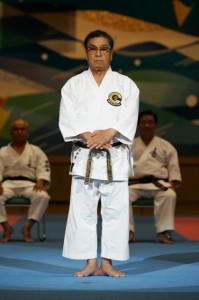 Hichiya Yoshio, 82 from Goju-ryu, was a senior student of Miyazato Eiichi (1922-1999), one of the senior pupils of the founder of Goju-ryu, Miyagi Chojun (1888-1953). After the death of Iha Koshin (1922-2012), Miyazato's long-time collaborator and successor, Hichiya became the third chairman of the Okinawa Goju-Ryu Karate-Do Kyokai and president of the Okinawa Prefecture Karatedo Federation. Hichiya's association consists of 12 dojo in Okinawa, 13 in mainland Japan, and many others in the USA, Europe, Asia, and other parts of the world.
Hichiya Yoshio, 82 from Goju-ryu, was a senior student of Miyazato Eiichi (1922-1999), one of the senior pupils of the founder of Goju-ryu, Miyagi Chojun (1888-1953). After the death of Iha Koshin (1922-2012), Miyazato's long-time collaborator and successor, Hichiya became the third chairman of the Okinawa Goju-Ryu Karate-Do Kyokai and president of the Okinawa Prefecture Karatedo Federation. Hichiya's association consists of 12 dojo in Okinawa, 13 in mainland Japan, and many others in the USA, Europe, Asia, and other parts of the world. 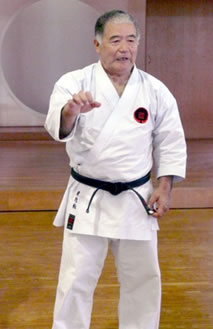 Higaonna Morio, at 74, the youngest of those named to this honor, is well known in Okinawa, Japan, the U.S. and the rest of the world as a master, teacher, writer, and performer of Goju-ryu. He is founder and Chief Instructor of the International Okinawan Goju-ryu Karate-do Federation (IOGKF) and received his 10th dan hanshi promotion in 2007. At the chief instructors meeting during the 6th World Budosai in Okinawa in July 2012, Higaonna announced his retirement from the position of IOGKF World Chief Instructor, and appointed Tetsuji Nakamura (7th dan) as the new IOGKF World Chief Instructor, and Ernie Molyneux and Henrik Larsen as new vice chief instructors. Higaonna will continue to travel and teach at international events, but has passed along administrative chores to a younger generation.
Higaonna Morio, at 74, the youngest of those named to this honor, is well known in Okinawa, Japan, the U.S. and the rest of the world as a master, teacher, writer, and performer of Goju-ryu. He is founder and Chief Instructor of the International Okinawan Goju-ryu Karate-do Federation (IOGKF) and received his 10th dan hanshi promotion in 2007. At the chief instructors meeting during the 6th World Budosai in Okinawa in July 2012, Higaonna announced his retirement from the position of IOGKF World Chief Instructor, and appointed Tetsuji Nakamura (7th dan) as the new IOGKF World Chief Instructor, and Ernie Molyneux and Henrik Larsen as new vice chief instructors. Higaonna will continue to travel and teach at international events, but has passed along administrative chores to a younger generation. 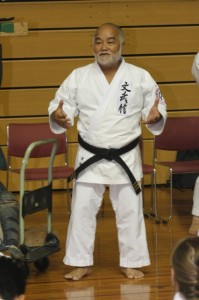 Nakamoto Masahiro, a 75-year-old specialist in Okinawan kobudo, is the first-ever kobudo master to receive the "intangible cultural asset" award. Nakamoto has become better known in the West with the translation of his book, Okinawan Kobudo (2008), but has been an important teacher and researcher for decades. Nakamoto claims to be the only living student of Taira Shinken (1897-1970) and a student of Oshiro Chojo (1888-1934), master of Yamane-ryu bojutsu. Given that Nakamoto was only three years old when Oshiro died, it is unclear how this was possible. He is one of the last remaining students of Chibana Choshin and also trained under Chibana's senior 9th dan, Nakama Chozo (1899-1982), one of Okinawa's most experienced and respected karate masters. In 1983, Nakamoto established the Okinawa Dento Kobudo Hozon Kai and he runs his own dojo and museum, the Bunbukan. He holds the rank of 10th dan hanshi in Kobayashi Shorinryu karate and Okinawa Kobudo.
Nakamoto Masahiro, a 75-year-old specialist in Okinawan kobudo, is the first-ever kobudo master to receive the "intangible cultural asset" award. Nakamoto has become better known in the West with the translation of his book, Okinawan Kobudo (2008), but has been an important teacher and researcher for decades. Nakamoto claims to be the only living student of Taira Shinken (1897-1970) and a student of Oshiro Chojo (1888-1934), master of Yamane-ryu bojutsu. Given that Nakamoto was only three years old when Oshiro died, it is unclear how this was possible. He is one of the last remaining students of Chibana Choshin and also trained under Chibana's senior 9th dan, Nakama Chozo (1899-1982), one of Okinawa's most experienced and respected karate masters. In 1983, Nakamoto established the Okinawa Dento Kobudo Hozon Kai and he runs his own dojo and museum, the Bunbukan. He holds the rank of 10th dan hanshi in Kobayashi Shorinryu karate and Okinawa Kobudo.Some thoughts on the 2013 awards:
First, this is the third set of awards as "intangible cultural assets" since Okinawa prefecture set up the program in 1997. (See their statement of purpose, below.) Previous recipients were:
Nagamine Shoshin (1907-1997, Matsubayashi-ryu)
Yagi Meitoku (1912-2003, Goju-ryu)
Itokazu Seiki (born 1915, Uechi-ryu)
Iha Koshin (1925-2012, Goju-ryu)
Tomoyose Ryuko (born 1928, Uechi-ryu)
Nakazato Shugoro (born 1921, Kobayashi Shorin-ryu)
Nakazato Joen (1922-2010, Shorinji-ryu Kyudokan)
Miyahira Katsuya (1918-2010, Kobayashi Shorin-ryu)
Wakugawa Kosei (born 1926, Goju-ryu)
Second, it is clear that those awarded this honor are all elderly, ranging from 74 to 88. They are all very senior masters with 60 years or more of training and teaching behind them. Not all are household names among foreign students of the martial arts-Wakugawa, Itokazu, and several of this year's recipients, for example, are not well known, except within their own styles-but all are highly regarded in Okinawa and all hold the rank of 10th dan hanshi.
Third, the awards are spread among the major styles of Okinawan martial arts. Shorin-ryu, Goju-ryu, and Uechi-ryu are by far the dominant groups receiving the awards. (Nakazato Joen was a student of Kiyan Chotoku, 1870-1945, and was thus arguably of "Shorin-ryu" lineage as well.) No other styles have been honored. This year was the first time a kobudo master was included. Both Matayoshi Shinpo (1921-1997) and Akamine Eisuke (1925-1999) were passed over, although both were alive in 1997 and at least as healthy and active as the retired and failing Nagamine Shoshin. As heads of the two major kobudo lineages, they almost certainly should have received the same honor.
Fourth, it must be remembered that there is a political process behind these awards. Yagi Meitoku was the widely acknowledge senior Goju-ryu practitioner in 1997, but his claim was not universally recognized. Both Miyazato Eiichi (1922-1999) and Toguchi Seikichi (1917-1998) were long-time students of Miyagi Chojun and/or Higa Seko (1898-1966), and Miyazato claimed seniority over Yagi. By contrast, Miyahira and Nakazato were both senior students of Chibana Choshin, though Miyahira was both the senior and Chibana's successor. Nonetheless, the committee decided to honor them both in 2000.
There are also economic considerations behind these awards. It seems clear that, at least since 2000, part of the purpose of these awards is to foster "karate tourism." The Okinawa Prefecture Government established an organization-the "Okinawa Traditional Karate Liaison Bureau"-with a web site (http://okkb.org) as part of the "Okinawa Traditional Karate Liaison Bureau Construction Project" under an "Okinawa Prefecture Culture and Arts Promotion - Industry Creation Support Project." They seem interested in accessing all those who practice some form of "traditional" Okinawan martial art and encouraging them to visit Okinawa (as opposed to mainland Japan). It is a body associated with both the regional government and the budo groups of local origin, in an effort to promote Okinawa. It is not by accident that the majority of those given this award since 2000 are regular participants in seminars set up specifically for visiting overseas groups of karate and kobudo students.
Fifth, in addition to the welcome surprise of adding a kobudo master to this year's recipients, the inclusion of Higaonna Morio is something of a surprise. Higaonna, who has a large worldwide following and is highly respected for his expertise, has something less of a sterling reputation within the often fractious Okinawan Goju-ryu community. Originally a student of Miyazato Eiichi, Higaonna received ranking only up to 7th dan from his teacher. He broke away from Miyazato, with considerable hard feelings at least for his teacher, and proclaimed himself a student of the relatively obscure Miyagi Anichi (1931-2009). Miyazato and some other Goju-ryu practitioners accused Higaonna of distorting history, raising Miyagi (no relation to the style's founder) above his actual status in Goju-ryu, and misleading the international community with his book, The History of Karate: Okinawan Goju-ryu. His promotions to 8th and 9th dan were awarded by Master Higa Yuchoku (1910-1994). Higa was a student of Miyagi Chojun's senior student, Shinzato Jinan (1900-1945) from about 1934-45, but switched to Shorin-ryu in 1948 and trained with Chibana Choshin until he died. Higaonna never trained under Higa, and arguably Higa was not qualified to promote anyone in Goju-ryu, a style he had essentially given up during World War II. Higaonna's 10th dan rank was apparently awarded by Miyagi Anichi. The award of Okinawa's "intangible cultural asset holder" suggests that Higaonna's ability and contributions have overcome any concerns about his lineage or legitimacy, but also underscore the political and economic motivation behind these awards: Higaonna is a major "draw" for overseas students to visit Okinawa.
"Okinawa Karatedo and Kobudo" are a precious cultural heritage that Okinawa is highly proud of. Due to the dedicated efforts of many people, they have been preserved and nurtured; they were officially designated an intangible cultural asset by Okinawa Prefecture in 1997.
"From its birthplace of Okinawa, karate expanded worldwide via mainland Japan. Nowadays, karate and similar combative sports can be found in 140 countries, where some 50,000,000 people are said to practice it as mental and physical training, an art of self-defense, or as sport. It also offers a fantastic example of development from a sport business point of view.
"Among many events held thus far, Okinawa Prefecture, together with Karatedo and Kobudo-related organizations, organized the '2003 Okinawa Karatedo & Kobudo World Tournament' in August of 2003, welcoming many overseas participants. This was an important international exchange step for Okinawa Karatedo & Kobudo.
"However, while Okinawa is the 'cradle of karate,' if compared with other combative sports, Okinawa Karatedo & Kobudo are somewhat lacking in organizational ability, funding, and developmental power as an international sports business.
"In a world where other similar combative sports are widely developing, we feel we need to act now in order to ensure that Okinawa Karatedo & Kobudo are properly inherited as cultural heritage, and that they see a new expansion as a cultural asset with economic value. Therefore, in cooperation with karate and economic circles, Okinawa needs to study, research and compare Okinawa Karatedo & Kobudo with other sports in an aim of reaching an objective awareness. In doing so, we will later on jointly promote a 'New Expansion Strategy,' working on improving the position of Okinawa Karatedo and Kobudo on the international karate scene.
"Our NPO, working with the Okinawa Prefectural Government and Okinawa Karatedo & Kobudo organizations, was established with the aim of supporting Okinawa Karatedo & Kobudo so they would further develop as important Okinawan cultural heritages and cultural properties." (http://okkb.org)